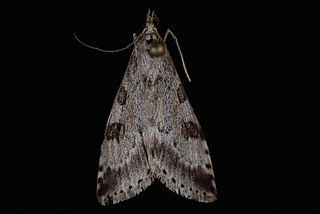Psammobotys is a genus of moths of the family Crambidae.

Elophila tinealis, the black duckweed moth, is a moth in the family Crambidae. It was described by Eugene G. Munroe in 1972. It is found in North America, where it has been recorded from Michigan, Ontario and New York, south to Florida and west to Texas. The habitat consists of swamps and wet woods.
Prorasea fernaldi is a moth in the family of Crambidae. It was described by Eugene G. Munroe in 1974. It is found in North America, where it has been recorded from Colorado, New Mexico and Wyoming.
Abegesta concha is a moth in the family Crambidae. It was described by Eugene G. Munroe in 1964. It is found in North America, where it has been recorded from Arizona, California and New Mexico.
Lipocosma septa, the exposed lipocosma moth, is a moth in the family Crambidae. It was described by Eugene G. Munroe in 1972. It is found in North America, where it has been recorded from Florida, Georgia, Maryland, North Carolina, Oklahoma, South Carolina, Texas and Virginia.
Anania quebecensis, the Quebec phlyctaenia moth, is a moth in the family Crambidae. It was described by Eugene G. Munroe in 1954. It is found in North America, where it has been recorded from Ontario to Nova Scotia and Maine, south to Maryland and Virginia.
Loxostege sierralis is a moth in the family Crambidae. It was described by Eugene G. Munroe in 1976. It is found in North America, where it has been recorded from British Columbia, Saskatchewan, Washington, Utah, Oregon and California.
Scoparia apachealis is a moth in the family Crambidae. It was described by Eugene G. Munroe in 1972. It is found in North America, where it has been recorded from Arizona, New Mexico and Utah.
Cymbopteryx fuscimarginalis is a moth in the family Crambidae. It was described by Eugene G. Munroe in 1961. It is found in North America, where it has been recorded from Arizona.
Frechinia texanalis is a moth in the family Crambidae. It was described by Eugene G. Munroe in 1961. It is found in North America, where it has been recorded from Texas.
Pogonogenys frechini is a moth in the family Crambidae. It was described by Eugene G. Munroe in 1961. It is found in North America, where it has been recorded from Washington.
Pogonogenys masoni is a moth in the family Crambidae. It was described by Eugene G. Munroe in 1961. It has been recorded in the United States of America in the state of California.
Psammobotys alpinalis is a moth in the family Crambidae. It was described by Eugene G. Munroe in 1972. It is found in North America, where it has been recorded from California.
Palpita kimballi, or Kimball's palpita moth, is a moth in the family Crambidae. It was described by Eugene G. Munroe in 1959. It is found in North America, where it has been recorded from Alabama, Florida, Georgia, Louisiana, North Carolina, Oklahoma, South Carolina, Tennessee and Virginia.
Palpita persimilis, the olive shootworm moth, is a moth in the family Crambidae. It was described by Eugene G. Munroe in 1959. It is found in Santa Catarina, Brazil.
Udea abstrusa is a moth in the family Crambidae. It was described by Eugene G. Munroe in 1966. It is found in North America, where it has been recorded from Alberta, British Columbia, Colorado, New Mexico, the Northwest Territory, Washington and Wyoming.
Udea beringialis is a moth in the family Crambidae. It was described by Eugene G. Munroe in 1966. It is found in North America, where it has been recorded from Alaska, Alberta, British Columbia, Manitoba and the Yukon Territory.
Udea brevipalpis is a moth in the family Crambidae. It was described by Eugene G. Munroe in 1966. It is found in North America, where it has been recorded from California, Colorado and Utah.
Udea cacuminicola is a moth in the family Crambidae. It was described by Eugene G. Munroe in 1966. It is found in North America, where it has been recorded from Colorado and Wyoming.

Udea washingtonalis, the Washington udea moth, is a moth in the family Crambidae. It was described by Augustus Radcliffe Grote in 1882. It is found in North America, where it has been recorded from Alaska, British Columbia, California, Montana and Washington.

